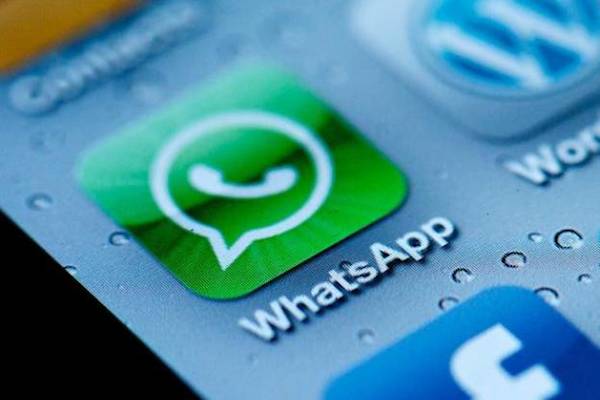
Why WhatsApp? And why $19 billion?: The arms race between Google, Facebook, and Twitter reached stunning new heights this week when Facebook announced it was buying the messaging app WhatsApp in a $19 billion deal — by comparison, it bought Instagram two years ago for $1 billion. The Wall Street Journal has a good overview of the deal, and Wired’s David Rowan and Forbes’ Parmy Olson gave the background on WhatsApp and its Ukrainian co-founder Jan Koum.
WhatsApp was founded in 2009, and since then it’s grown to some 450 million users — a faster growth rate than Facebook, Twitter, or any other company in history, as its investors, Sequoia Capital, noted. Many of those users are outside the U.S., in countries like Brazil, Spain, and Russia, where WhatsApp has gained a toehold through carrier deals and word-of-mouth marketing. WhatsApp is intended to be a better form of text messaging, and it’s especially useful for people to send international texts without racking up SMS fees. (The New York Times’ Farhad Manjoo looked at the positive influence WhatsApp has had in dropping phone carriers’ SMS prices.)
Despite WhatsApp’s incredible growth, the deal’s enormous price tag triggered skepticism for one big reason in particular: WhatsApp doesn’t sell ads, and it doesn’t charge its users more than $1 a year. This kind of sky-high price for a young app without any evident revenue prospects prompted a lot of talk about desperation and a tech bubble from people like Salon’s Andrew Leonard and the BBC’s Rory Cellan-Jones, among many others.
This, of course, led to the central question surrounding the WhatsApp deal: Why is WhatsApp worth so much to Facebook? There were quite a few explanations thrown out, starting with the official story from Facebook’s Mark Zuckerberg: It’s growing phenomenally quickly, and its users return to it even more regularly than Facebook’s users do. Sure, but what else?
At the most basic level, it was probably fear of competition. BuzzFeed’s John Herrman explained why the new wave of simple messaging apps are so terrifying to Facebook, as they encroach on its most valuable turf of smartphone and text conversations: “It’s drawing from the same limited pool of attention, and accommodating some of Facebook’s most addicting behaviors,” he said. Still, Om Malik of Gigaom said Facebook and WhatsApp aren’t doing quite the same thing: WhatsApp is synchronous and immediate, while Facebook is still oriented around the status update, so Facebook is buying a new type of user behavior. Reuters’ Felix Salmon said Facebook isn’t buying WhatsApp because it’s a particularly good app, but because it won the popularity lottery that mobile development often comes down to.
As TechCrunch’s Josh Constine and BoingBoing’s Xeni Jardin noted, Facebook is also buying substantial inroads to key international markets such as Europe and Latin America. Alternatively, Recode’s Kara Swisher argued that in paying a jaw-dropping amount for a must-have mobile messaging app, Facebook was essentially paying the price for not having a mobile operating system like Google and Apple have. And PandoDaily’s Sarah Lacy said the deal is actually fundamentally about Facebook maintaining its dominance over the world’s shared photos, as WhatsApp processes 500 million photos a day — more than Facebook, Snapchat, or Instagram.
In reality, it’s probably a bit of all of those reasons, and as Forbes’ Robert Hof noted, we probably won’t really know the utility of WhatsApp to Facebook for a long time. Swisher and The Verge’s Ellis Hamburger argued that Facebook is acting like a Disney-esque conglomerate, trying to scoop up and dominate as many forms of public and private communication as it can. As The Guardian’s Stuart Dredge put it, the average person’s smartphone is tending toward apps that do one thing well, in which case “Facebook wants to be providing as many of them as possible. And if it can’t build successful enough standalone apps, it will buy them.”

Several other observers focused on the deal’s implications for the broadband industry, including Mother Jones’ Kevin Drum, who argued that the acquisition “would probably deal a serious blow to our ability to use the internet the way we want, not the way Comcast wants us to.” Comcast is intent on limiting competition to its cable TV business from streaming video, and The New York Times’ Farhad Manjoo noted that Comcast’s broadband pricing is attempting to limit the financial advantage to cord-cutting as much as possible. Reuters’ Felix Salmon likewise compared the strategy of limiting broadband competition and keeping prices high to a newspaper’s online paywall: “they’re not so much a way of making lots of money themselves, as they are a way of persuading you to pay lots of money for something else. (Physical newspaper delivery, or cable TV.)”
This strategy sounds a lot like old-school monopolistic behavior, something the Times’ Paul Krugman argued. But Jack Shafer of Reuters said this monopoly was a government-made one through decades of poorly implemented regulation. The key to rescuing the broadband/cable industry, he said, is to remove regulatory barriers that benefit incumbents like Comcast.
Elsewhere in the struggle between the cable industry and online video, the U.S. Federal Communications Commission announced it plans to issue new net neutrality guidelines after the previous ones were struck down earlier this year, and the Obama administration signaled its support for the proposal. As Recode’s Amy Schatz explained, the new rules aren’t much different from the old ones; they’re just justified through a different part of the law. Open Internet advocates, as The Verge’s Adi Robertson reported, are expressing their disappointment that the FCC isn’t going to classify broadband providers as common carriers, regulating them as public utilities.
Without a strong net neutrality framework in place, fights like the one between Verizon and Netflix will continue to get nastier. As the (paywalled) Wall Street Journal reported (summary at the free Ars Technica), that feud is flaring up as Verizon is demanding payments for carrying what it calls excessive traffic, and since Netflix is refusing, Verizon is slowing down Netflix’s streaming over its network. As Ars Technica noted, Netflix is putting pressure on ISPs itself, pushing them to connect to its distribution network in order to give its customers “Super HD” Netflix video.

The NSA and WikiLeaks: Still more news continues to drip out of the U.S. National Security Agency documents leaked by Edward Snowden — this week brought stories of the NSA spying on a U.S. law firm representing Indonesia in a trade dispute with the U.S., and of NSA and British GCHQ surveillance of activist groups like WikiLeaks and Anonymous and the file-sharing site Pirate Bay. The Verge’s Adi Robertson gave some more explanation of the latter report, noting that these documents are a little less conclusive than others that have been leaked.
Tim Cushing of Techdirt pointed out the threat of users’ data being swept in NSA surveillance of The Pirate Bay, and Trevor Timm of the Freedom of the Press Foundation condemned the tactics against WikiLeaks as an attack on press freedom. Alexa O’Brien, a journalist who has covered WikiLeaks and the Chelsea Manning case, also published new court documents that provide some new details on the U.S. Department of Justice’s surveillance of a WikiLeaks associate during its investigation into WikiLeaks and its founder, Julian Assange.
Meanwhile, Britain’s High Court upheld the legality of the U.K.’s detention under anti-terrorism laws of David Miranda, partner of The Intercept’s Glenn Greenwald, for his possession of the Snowden documents last August. Greenwald, the Freedom of the Press Foundation’s Timm, and Firedoglake’s Kevin Gosztola all criticized the court for accepting the U.K. government’s argument that publication of the Snowden documents fell under the terrorism statute, calling the ruling an attack on journalism.
Reading roundup: A few other stories that drew some discussion this week:
— Some additional pieces of the ongoing conversation about Facebook and viral publishers: Salon’s Alex Pareene looked at Facebook’s News Feed algorithm changed and the relationship between viral content and making money in online publishing, and Mathew Ingram of Gigaom pushed back against the report that Upworthy’s traffic was crushed by that algorithm tweak, while Len Kendall defended Upworthy’s approach more generally. The Lab’s Caroline O’Donovan also examined BuzzFeed’s shift toward quizzes as its most ubiquitous form of viral content. — LinkedIn expanded its publishing platform, which had been limited to a number of “influencers,” to all of its users. The New York Times looked at the move as a way to boost its sagging usage rate, and Gigaom’s Mathew Ingram noted that LinkedIn has the advantage of having an existing revenue-generating business that can subsidize its publishing arm. Meanwhile, former New York Times digital editor Martin Nisenholtz and Sulia’s Jonathan Glick wondered whether the Times should consider becoming a publishing platform, too.— The Women’s Media Center released its annual report on the status of women in the American media, and as Sara Morrison at Poynter and Edirin Oputu at the Columbia Journalism Review both noted, the numbers are pretty dismal in every category, especially in sports. Slate’s Amanda Hess did point out a couple of organizations that are leading the way in making sure women are represented — MSNBC and ESPN.
— Boston magazine published a long profile of new Boston Globe owner John Henry, and it included the nugget, helpfully highlighted by the Lab’s Joshua Benton, that the paper is switching its paid site, BostonGlobe.com, from a hard paywall to a metered model.— Finally, Microsoft researcher danah boyd gave interesting Q&As to Fast Company and Slate about teens’ use of social media based on her new book on the subject.
Photo of WhatsApp by Tecnomovida Caracas and image of Ethernet cable by Bert Boerland used under a Creative Commons license.